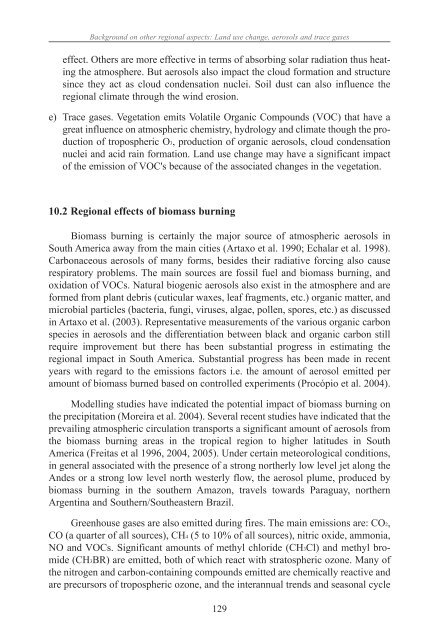chapter - Atmospheric and Oceanic Science
chapter - Atmospheric and Oceanic Science
chapter - Atmospheric and Oceanic Science
You also want an ePaper? Increase the reach of your titles
YUMPU automatically turns print PDFs into web optimized ePapers that Google loves.
Background on other regional aspects: L<strong>and</strong> use change, aerosols <strong>and</strong> trace gases<br />
effect. Others are more effective in terms of absorbing solar radiation thus heating<br />
the atmosphere. But aerosols also impact the cloud formation <strong>and</strong> structure<br />
since they act as cloud condensation nuclei. Soil dust can also influence the<br />
regional climate through the wind erosion.<br />
e) Trace gases. Vegetation emits Volatile Organic Compounds (VOC) that have a<br />
great influence on atmospheric chemistry, hydrology <strong>and</strong> climate though the production<br />
of tropospheric O3, production of organic aerosols, cloud condensation<br />
nuclei <strong>and</strong> acid rain formation. L<strong>and</strong> use change may have a significant impact<br />
of the emission of VOC's because of the associated changes in the vegetation.<br />
10.2 Regional effects of biomass burning<br />
Biomass burning is certainly the major source of atmospheric aerosols in<br />
South America away from the main cities (Artaxo et al. 1990; Echalar et al. 1998).<br />
Carbonaceous aerosols of many forms, besides their radiative forcing also cause<br />
respiratory problems. The main sources are fossil fuel <strong>and</strong> biomass burning, <strong>and</strong><br />
oxidation of VOCs. Natural biogenic aerosols also exist in the atmosphere <strong>and</strong> are<br />
formed from plant debris (cuticular waxes, leaf fragments, etc.) organic matter, <strong>and</strong><br />
microbial particles (bacteria, fungi, viruses, algae, pollen, spores, etc.) as discussed<br />
in Artaxo et al. (2003). Representative measurements of the various organic carbon<br />
species in aerosols <strong>and</strong> the differentiation between black <strong>and</strong> organic carbon still<br />
require improvement but there has been substantial progress in estimating the<br />
regional impact in South America. Substantial progress has been made in recent<br />
years with regard to the emissions factors i.e. the amount of aerosol emitted per<br />
amount of biomass burned based on controlled experiments (Procópio et al. 2004).<br />
Modelling studies have indicated the potential impact of biomass burning on<br />
the precipitation (Moreira et al. 2004). Several recent studies have indicated that the<br />
prevailing atmospheric circulation transports a significant amount of aerosols from<br />
the biomass burning areas in the tropical region to higher latitudes in South<br />
America (Freitas et al 1996, 2004, 2005). Under certain meteorological conditions,<br />
in general associated with the presence of a strong northerly low level jet along the<br />
Andes or a strong low level north westerly flow, the aerosol plume, produced by<br />
biomass burning in the southern Amazon, travels towards Paraguay, northern<br />
Argentina <strong>and</strong> Southern/Southeastern Brazil.<br />
Greenhouse gases are also emitted during fires. The main emissions are: CO2,<br />
CO (a quarter of all sources), CH4 (5 to 10% of all sources), nitric oxide, ammonia,<br />
NO <strong>and</strong> VOCs. Significant amounts of methyl chloride (CH3Cl) <strong>and</strong> methyl bromide<br />
(CH3BR) are emitted, both of which react with stratospheric ozone. Many of<br />
the nitrogen <strong>and</strong> carbon-containing compounds emitted are chemically reactive <strong>and</strong><br />
are precursors of tropospheric ozone, <strong>and</strong> the interannual trends <strong>and</strong> seasonal cycle<br />
129






